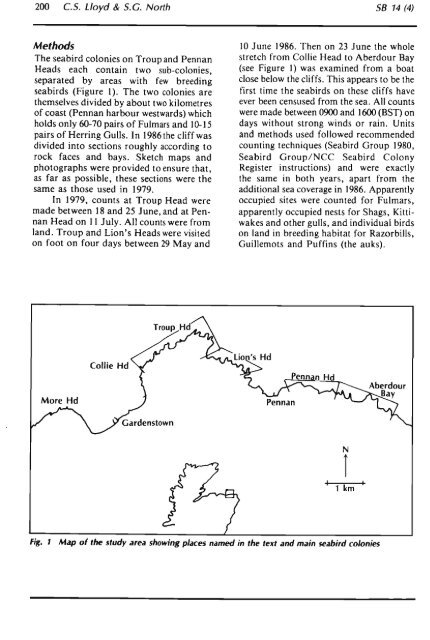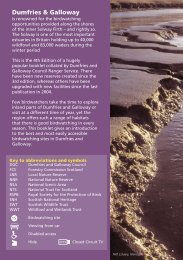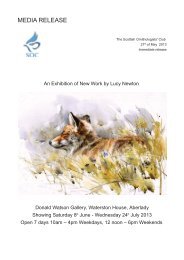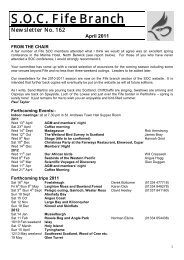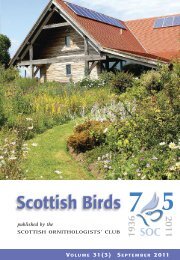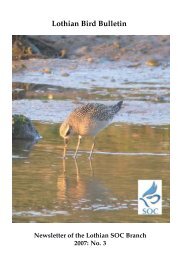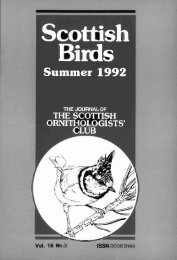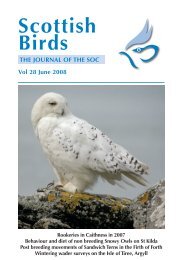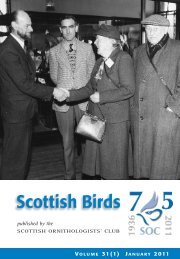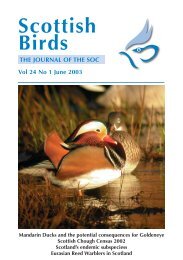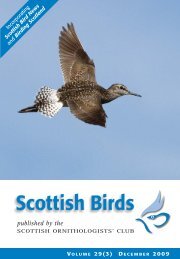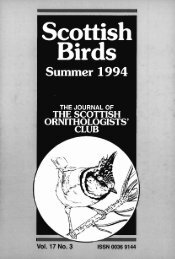V 14 No.4 - The Scottish Ornithologists' Club
V 14 No.4 - The Scottish Ornithologists' Club
V 14 No.4 - The Scottish Ornithologists' Club
Create successful ePaper yourself
Turn your PDF publications into a flip-book with our unique Google optimized e-Paper software.
200 C.S. Lloyd & S.C. North<br />
S8 <strong>14</strong> (4)<br />
Methods<br />
<strong>The</strong> seabird colonies on Troup and Pennan<br />
Heads each contain two sub-colonies,<br />
separated by areas with few breeding<br />
seabirds (Figure 1). <strong>The</strong> two colonies are<br />
themselves divided by about two kilometres<br />
of coast (pennan harbour westwards) which<br />
holds only 60-70 pairs of Fulmars and 10-15<br />
pairs of Herring Gulls. In 1986 the cliff was<br />
divided into sections roughly according to<br />
rock faces and bays. Sketch maps and<br />
photographs were provided to ensure that,<br />
as far as possible, these sections were the<br />
same as those used in 1979.<br />
In 1979, counts at Troup Head were<br />
made between 18 and 25 June, and at Pennan<br />
Head on 11 July. All counts were from<br />
land. Troup and Lion's Heads were visited<br />
on foot on four days between 29 May and<br />
10 June 1986. <strong>The</strong>n on 23 June the whole<br />
stretch from Collie Head to Aberdour Bay<br />
(see Figure 1) was examined from a boat<br />
close below the cliffs. This appears to be the<br />
first time the seabirds on these cliffs have<br />
ever been censused from the sea. All counts<br />
were made between 0900 and 1600 (BST) on<br />
days without strong winds or rain. Units<br />
and methods used followed recommended<br />
counting techniques (Sea bird Group 1980,<br />
Sea bird Group/NCC Seabird Colony<br />
Register instructions) and were exactly<br />
the same in both years, apart from the<br />
additional sea coverage in 1986. Apparently<br />
occupied sites were counted for Fulmars,<br />
apparently occupied nests for Shags, Kittiwakes<br />
and other gulls, and individual birds<br />
on land in breeding habitat for Razorbills,<br />
Guillemots and Puffins (the auks).<br />
N<br />
I<br />
1 km<br />
Fig. 1 Map of the study area showing places named in the text and main seabird colonies


